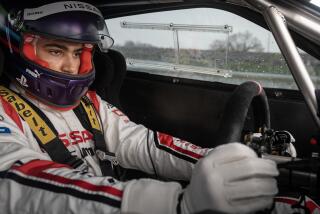Behind the Wheel With Jackie Stewart--for Real This Time
- Share via
DETROIT — The helmet is on. Seat belts are fastened tight. The green flag is waved, and it’s onto the track to get acquainted with each and every turn.
“Boy, this is hot stuff,” you murmur as you shift the gears of a shiny Ford Thunderbird Turbo Coupe, trying to drive as close to the inside of the curves as possible without bumping the car’s fat black tires onto the grass.
After a couple of laps, the Bird’s tires begin to squeal through the corners--which means you are going faster. And that means your lap times are getting better.
“Watch out, Mario Andretti! Look out Ayrton Senna! Move over, Paul Newman!” you fantasize as you grip the steering wheel tightly, trying not to let up on the accelerator.
Then reality sets in, but oh, what a reality it is.
“Just slow down a wee bit and relax. Start coming out of the corners more. Let the car breathe. Give it some play, like a fine race horse,” says the diminutive Scotsman brave enough to don his trademark plaid-striped helmet and strap himself in beside me. “Much better. Very smooth.”
‘Fine Art of Driving’
That brave man is Jackie Stewart, winner of a record 27 World Championship Grands Prix and three Formula One Driver Championships during his 12-year racing career. Stewart, who now works for Ford Motor Co. as a consultant for its new vehicle development programs, is one of the biggest names in auto racing, and probably the best known one outside the sport.
And he’s teaching me what he calls “the fine art of driving.”
“Good driving is smooth driving,” Stewart says during a short classroom lecture at Ford’s test track in Dearborn, Mich., before the driving begins. “It is exactly the same technique I use in driving a road car as I do in a race car,” he tells a handful of automotive writers invited for a day of intensive instruction.
“In fact, the world’s best drivers--Juan Fangio, Stirling Moss, Jim Clark, and Alain Prost--are never spectacular or smooth,” he says. “They are spectacularly skilled in an unspectacular fashion.”
Throughout the course, Stewart emphasizes that smooth driving pays off in all ways. “The driver is less tired, the car is less abused, and your passengers are not exhausted from pitching back and forth.”
Attention to Technique
Then some technical stuff, but things that make perfectly good sense if one takes the time to think about it.
For instance, braking too hard before making a turn causes a car to nose-dive, meaning its front suspension is pressed down. That means it has nothing left to work with to let the driver control the car.
Conversely, jack-rabbit starts cause the front suspension to lift, pulling the tires from the road. That reduces the driver’s ability to steer.
Stewart peppers his talks with humor, but the lesson is truth. “There are only two ways to really insult people,” he says. “One is to call them a bad lover. The other is to call them a bad driver. And they won’t believe either of them.”
Then we get behind the wheel of a car with a large plastic bowl taped to its hood. Inside the dish is a red ball. The object of this exercise is to drive around a small, peanut-shaped course without hitting the pylons or spilling the ball from the dish--all in a reasonable amount of time.
Pointers on Course
Next, Stewart takes each of us around the large test track, showing us the basics of smooth driving. We are moving through the turns at nearly 100 m.p.h., feeling only the G-forces at the curves but never being jostled about. This is where smoothness meets speed, and Stewart is the master.
It is then critique time, and one writer in the class is just too scared to drive with Stewart beside her. But they are soon under way.
The one guarantee made at the beginning of the day comes true. Everyone has come away being smoother, safer and more aware drivers, learning things every motorist should know before being granted a license.
More to Read
Go beyond the scoreboard
Get the latest on L.A.'s teams in the daily Sports Report newsletter.
You may occasionally receive promotional content from the Los Angeles Times.










